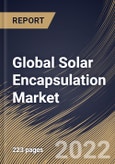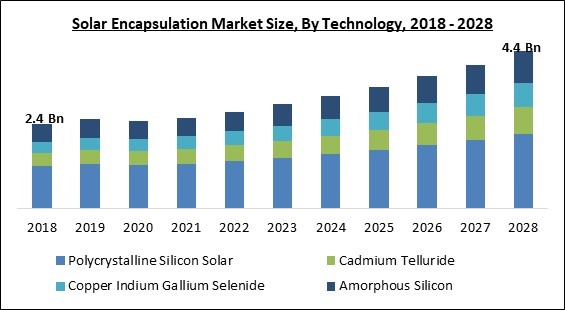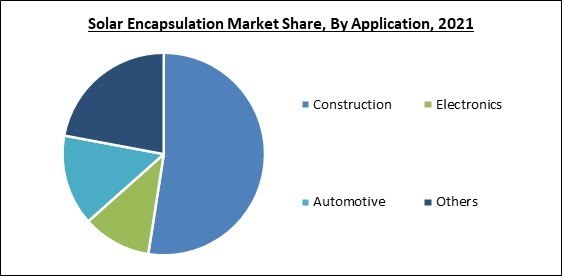The Global Solar Encapsulation Market size is expected to reach $4.4 billion by 2028, rising at a market growth of 8.4% CAGR during the forecast period.
Barrier films and adhesives are layered in multiple layers on the back sheets of solar modules. By lowering the cost of partial modules, the back-sheet construction helps to increase solar module efficiency by shielding the solar cells from various environmental factors like UV exposure, moisture, and other performance threats. The solar cell is shielded by the encapsulation film, which also guarantees its dependability and performance. By keeping the moisture out, it serves to provide optical and electrical transmissivity. The manufacturing of modules can benefit from increased efficiencies due to encapsulants. A crucial stage in the creation of solar cells is encapsulation. Even the best solar cells cannot create good solar modules without a good encapsulation process.
Urbanization increased demand for solar panels, which in turn raised encapsulation demand, which may be the main factor driving the market. Additionally, the market for solar encapsulation has a lot of growth potential due to the increase in demand for solar lights for street and road dividers.
These factors include the significant increase in demand for solar lights for road dividers and streets, amazing benefits of solar cell encapsulation such as increased attack strength, increased longevity of solar cells, and improved efficiencies of encapsulants in module manufacturing processes. The growing acceptance of solar as a reliable and limitless source of energy and a rise in public awareness of renewable energy sources are also expected to benefit solar encapsulation.
The market research report covers the analysis of key stake holders of the market. Key companies profiled in the report include 3M Company, Dupont De Nemours, Inc., First Solar, Inc., Dai Nippon Printing Co., Ltd. (dnpSolar), Dow, Inc., Hangzhou First PV Material Co. Ltd., Kuraray Co., Ltd.
Barrier films and adhesives are layered in multiple layers on the back sheets of solar modules. By lowering the cost of partial modules, the back-sheet construction helps to increase solar module efficiency by shielding the solar cells from various environmental factors like UV exposure, moisture, and other performance threats. The solar cell is shielded by the encapsulation film, which also guarantees its dependability and performance. By keeping the moisture out, it serves to provide optical and electrical transmissivity. The manufacturing of modules can benefit from increased efficiencies due to encapsulants. A crucial stage in the creation of solar cells is encapsulation. Even the best solar cells cannot create good solar modules without a good encapsulation process.
Urbanization increased demand for solar panels, which in turn raised encapsulation demand, which may be the main factor driving the market. Additionally, the market for solar encapsulation has a lot of growth potential due to the increase in demand for solar lights for street and road dividers.
These factors include the significant increase in demand for solar lights for road dividers and streets, amazing benefits of solar cell encapsulation such as increased attack strength, increased longevity of solar cells, and improved efficiencies of encapsulants in module manufacturing processes. The growing acceptance of solar as a reliable and limitless source of energy and a rise in public awareness of renewable energy sources are also expected to benefit solar encapsulation.
COVID-19 Impact Analysis
Due to the COVID-19 situation's high peak, solar encapsulation production was put on hold for a set period of time, which had a significant negative impact on sales. Demand for solar panels is inversely correlated with sales of solar encapsulation. The COVID-19 outbreak-induced lockdown had a negative effect on solar projects, which saw a sharp drop in solar encapsulation. Nearly all industries were impacted by COVID-19 because it interfered with various industrial processes and the supply chain. Most businesses stopped operating because of a lack of workers.Market Growth Factors
Rooftop Photovoltaic (PV) Installation Demand is increasing
The growing market for solar encapsulation is being driven by the expanding demand for rooftop photovoltaic (PV) installation in developing nations. A PV system is an electric power system that uses photovoltaics (PV) to produce using solar power. It consists of a combination of parts, including solar panels that take in and transform sunlight into electricity. There has been a significant shift toward renewable energy sources, such as solar energy, and the construction of PV systems, particularly rooftop PV installations, as a result of growing environmental concerns and the depletion of conventional energy sources.Wide Adoption of Solar Panels
Many industries are embracing solar energy as a sustainable source of energy. This has mostly been made possible by solar panel manufacturers who invest a lot of money into cleverly making solar panels and related components instead of depending on their competitors. In the future, solar energy will be used more widely, not just in the residential and commercial sectors but also in households. Access to solar energy resources is growing and is probably going to get better.Market Restraining Factors
High Cost of Installation
The high initial cost of purchasing and installation is one of the drawbacks of solar electricity. The price of installing solar panels varies depending on the installation type, accessories, and solar panels. In the event of substantial installations, it might even go beyond this. Although it saves money over time by lowering electricity costs and lowering carbon footprints the initial cost for solar panels is high. Therefore, many of the users run out of budget while installing. Solar panels, wiring, and batteries are all part of this and add up to the cost.Material Outlook
Based on Material, the solar encapsulation market is segmented into Ethylene Vinyl Acetate, Non-ethylene Vinyl Acetate, UV Curable Resin, and others. The UV curable resin segment acquired a significant revenue share in the solar encapsulation market in 2021. To create a single unit that can function independently as a power source, solar cells are linked together in parallel or series. It is required to connect them in series or parallel in order to access the power supply because a single solar cell's output power is insufficient to meet the need for conventional power.Technology Outlook
On the basis of technology, the solar encapsulation market is fragmented into polycrystalline silicon solar, cadmium telluride, copper indium gallium selenide, and amorphous silicon. The polycrystalline silicon solar segment held the highest revenue share in the solar encapsulation market in 2021. These solar cells are popular and provide efficiencies between 15 and 25 percent. In polycrystalline solar panels, solar cells with a metal flakes appearance were produced from polycrystalline wafers cut from blocks of molten silicon, comprised of melted silicon fragments.Application Outlook
By application, the solar encapsulation market is divided into constructions, electronics, automotive and others. The electronic segment generated a significant revenue share in the solar encapsulation market in 2021. Electrical components are shielded from the environment using a process called electronic encapsulation. This can be accomplished by substances like epoxy, silicone, or potting compound. Electronic encapsulation is the process of covering an electronic assembly in a substance to protect it from shock, vibration, and corrosion.Regional Outlook
Region wise, the solar encapsulation market is analyzed across North America, Europe, Asia Pacific and LAMEA. In 2021, the Asia Pacific region led the solar encapsulation market with the largest revenue share. Large consumer base, industrialization, and urbanization are considerations. The rapid adoption of electrical products and rising industry has increased energy demand.The market research report covers the analysis of key stake holders of the market. Key companies profiled in the report include 3M Company, Dupont De Nemours, Inc., First Solar, Inc., Dai Nippon Printing Co., Ltd. (dnpSolar), Dow, Inc., Hangzhou First PV Material Co. Ltd., Kuraray Co., Ltd.
Scope of the Study
Market Segments Covered in the Report:
By Material
- Ethylene Vinyl Acetate
- Non-ethylene Vinyl Acetate
- UV Curable Resin
- Others
By Technology
- Polycrystalline Silicon Solar
- Cadmium Telluride
- Copper Indium Gallium Selenide
- Amorphous Silicon
By Application
- Construction
- Electronics
- Automotive
- Others
By Geography
- North America
- US
- Canada
- Mexico
- Rest of North America
- Europe
- Germany
- UK
- France
- Russia
- Spain
- Italy
- Rest of Europe
- Asia Pacific
- China
- Japan
- India
- South Korea
- Singapore
- Malaysia
- Rest of Asia Pacific
- LAMEA
- Brazil
- Argentina
- UAE
- Saudi Arabia
- South Africa
- Nigeria
- Rest of LAMEA
Key Market Players
List of Companies Profiled in the Report:
- 3M Company
- Dupont De Nemours, Inc.
- First Solar, Inc.
- Dai Nippon Printing Co., Ltd. (dnpSolar)
- Dow, Inc.
- Hangzhou First PV Material Co. Ltd.
- Kuraray Co., Ltd.
Unique Offerings from the Publisher
- Exhaustive coverage
- The highest number of Market tables and figures
- Subscription-based model available
- Guaranteed best price
- Assured post sales research support with 10% customization free
Table of Contents
Chapter 1. Market Scope & Methodology
Chapter 2. Market Overview
Chapter 3. Global Solar Encapsulation Market by Material
Chapter 4. Global Solar Encapsulation Market by Technology
Chapter 5. Global Solar Encapsulation Market by Application
Chapter 6. Global Solar Encapsulation Market by Region
Chapter 7. Company Profiles
Companies Mentioned
- 3M Company
- Dupont De Nemours, Inc.
- First Solar, Inc.
- Dai Nippon Printing Co., Ltd. (dnpSolar)
- Dow, Inc.
- Hangzhou First PV Material Co. Ltd.
- Kuraray Co., Ltd.
Methodology

LOADING...










